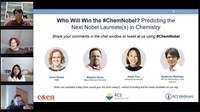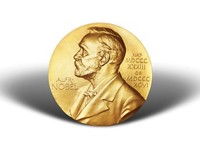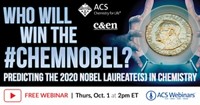Advertisement
Grab your lab coat. Let's get started
Welcome!
Welcome!
Create an account below to get 6 C&EN articles per month, receive newsletters and more - all free.
It seems this is your first time logging in online. Please enter the following information to continue.
As an ACS member you automatically get access to this site. All we need is few more details to create your reading experience.
Not you? Sign in with a different account.
Not you? Sign in with a different account.
ERROR 1
ERROR 1
ERROR 2
ERROR 2
ERROR 2
ERROR 2
ERROR 2
Password and Confirm password must match.
If you have an ACS member number, please enter it here so we can link this account to your membership. (optional)
ERROR 2
ACS values your privacy. By submitting your information, you are gaining access to C&EN and subscribing to our weekly newsletter. We use the information you provide to make your reading experience better, and we will never sell your data to third party members.
People
Nobel Prize Hangout
by Rudy M. Baum
October 6, 2014
| A version of this story appeared in
Volume 92, Issue 40
This week is Nobel Prize week, the week when scientists the world over wait with bated breath for word of who will be anointed by the Swedes with the most coveted and prestigious of awards.
Nobel Prize winners invariably express surprise that they were chosen for the award, but don’t be fooled. Everyone out there knows who the chemists, physicists, and biologists are who have compiled a body of work or made a singular discovery that’s worthy of Nobel recognition.
Last week, C&EN, Science News, and Smithsonian magazine hosted Google Hangouts devoted to predicting this year’s winners of, respectively, the Nobel Prizes in Chemistry, Physics, and Physiology or Medicine. I’m sure some C&EN readers are asking themselves, “What’s a Google Hangout?” Simply, it’s a way for a group of people in disparate locations to use their computers to get together and talk about a subject using a Google app, broadcast their chat for free, and interact with their audience via Twitter.
Instead of trying to explain, it probably makes more sense for you to take a look at C&EN’s archived hangout at cenm.ag/2014chemnobel. Our hangout was hosted by Senior Editor Carmen Drahl and Deputy Assistant Managing Editor Lauren Wolf talking with Neil Withers, features editor for Chemistry World magazine; Stuart Cantrill, chief editor for Nature Chemistry; and David Pendlebury, a citation analyst for Thomson Reuters. Using Twitter, Lila Guterman of Science News accepted questions (including one from me!) during the broadcast, which participants answered on-air.
So what did our prognosticators say about this year’s prize in chemistry?
Pendlebury uses what he called an “analytical approach” to make his predictions, which are based on citations of chemists’ work. He noted that 2014 is the 50th anniversary of the Thomson Reuters Science Citation Index, originally created by Eugene Garfield at the Institute for Scientific Information. Pendlebury said that Garfield observed that Nobel Prize winners are cited in the literature 30 to 50 times more often than average scientists.
On the basis of his analysis, Pendlebury predicted three possible Chemistry Nobel Prizes: Ching W. Tang of the University of Rochester and Steven Van Slyke of Kateeva Inc. for their invention of the organic light-emitting diode; Charles T. Kresge of Saudi Aramco, Ryong Ryoo of Korea Advanced Institute of Science & Technology, and Galen D. Stucky of the University of California, Santa Barbara, for their design of functional mesoporous materials; and Graeme Moad, Ezio Rizzardo, and San H. Thang, all of Commonwealth Scientific and Industrial Research Organisation (CSIRO) in Australia, for the development of the reversible addition-fragmentation chain transfer (RAFT) polymerization process.
Withers and Cantrill made their predictions based more on gut feeling than citation analysis. Withers participated in C&EN’s Nobel hangout last year and predicted that John B. Goodenough, University of Texas, Austin, would win for the development of the lithium-ion rechargeable battery. “As he didn’t win last year, and not a lot has changed—we’re still using lithium-ion batteries—I’m still going to go with that.”
Cantrill endorsed Withers’s pick of Goodenough but added his own pick, Michael Grätzel of the Swiss Federal Institute of Technology, Lausanne, for developing dye-sensitized solar cells. (You can view “Stu’s Shortlist” of possible Chemistry Nobel Prize winners on Twitter, @stuartcantrill.)
Drahl and Wolf made their own predictions during the hangout. Like Withers, Drahl and Wolf stuck with their predictions from last year: Wolf picked Stanford University professors Richard N. Zareand W. E. Moerner for their work on single-molecule spectroscopy, and Drahl tapped Pierre Chambon of the Institute of Genetics & Molecular Cellular Biology in France, Ronald M. Evans of the Salk Institute, and Elwood V. Jensen of the University of Cincinnati for the discovery of the superfamily of nuclear hormone receptors. (Cantrill noted that Jensen had recently passed away.)
As for myself, I’m picking Caltech’s Harry B. Gray to share the prize for his work on electron transfer.
By the time you read this, we’ll probably know whether any of us got it right this year.
Thanks for reading.
Views expressed on this page are those of the author and not necessarily those of ACS.





Join the conversation
Contact the reporter
Submit a Letter to the Editor for publication
Engage with us on Twitter